

Greek Gods Family Tree. Ludios.org.
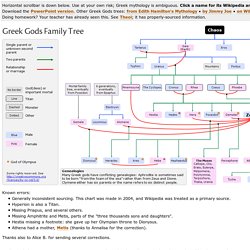
Family tree of the Greek gods. Key: The essential Olympians' names are given in bold font.
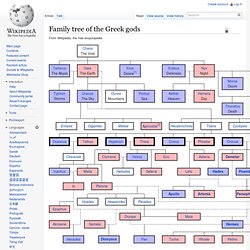
See also List of Greek mythological figures Notes External links Media related to Family trees of Greek mythology at Wikimedia Commons. Ordering the Heavens: A Visual History of Mapping the Universe. By Maria Popova From Copernicus to Ancient Korea, or what the Chinese concept of change has to do with Aztec astrology.
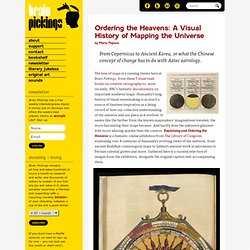
The love of maps is a running theme here at Brain Pickings, from these 7 must-read books on creative cartography to, most recently, BBC’s fantastic documentary on important medieval maps. Sami shamanism. Animal spirits[edit] Aside from the Bear Cult, there are other animal spirits such as the Haldi who watched over nature. Some Sami people had a thunder god called Tiermes, sometimes called Horagalles. Radien or Vearalden was a sky-ruling god. Folklore & Mythology. Geri and Freki. The god Odin enthroned and flanked by the wolves Geri and Freki and the ravens Huginn and Muninn as illustrated (1882) by Carl Emil Doepler. Saturn (mythology) Saturn (Latin: Saturnus) is a god in ancient Roman religion, and a character in myth. Saturn is a complex figure because of his multiple associations and long history. He was the first god of the Capitol, known since the most ancient times as Saturnius Mons, and was seen as a god of generation, dissolution, plenty, wealth, agriculture, periodic renewal and liberation.
In later developments he came to be also a god of time. His reign was depicted as a Golden Age of plenty and peace. Mari (goddess) Modern rendering of Mari by Josu Goñi Margaret Bullen has noted "the myth of Mari brings together male and female attributes and qualities", and that Mari is to be regarded as "a model of androgyny and a metaphor for liberation in which sexual difference should cease to be the basis for inequality".[3] Anboto is one of the mountains where Mari is supposed to live In various legends, Mari is said to have sons or daughters, but their number and character fluctuate.
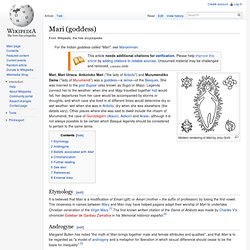
The two most well-known were her two sons, Atxular and Mikelatz. Atxular represents largely the Christianized Basque soul, becoming a priest after having learned from the Devil in a church in Salamanca and then having escaped. Another legend presents Mari as wife to the Lord of Biscay, Diego López I de Haro. Other legends are more simple. Huginn and Muninn. Huginn and Muninn sit on Odin's shoulders in an illustration from an 18th-century Icelandic manuscript In Norse mythology, Huginn (from Old Norse "thought"[1]) and Muninn (Old Norse "memory"[2] or "mind"[3]) are a pair of ravens that fly all over the world, Midgard, and bring information to the god Odin.
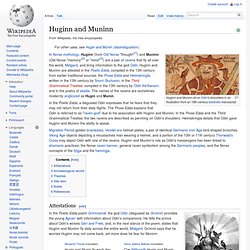
Weaving (mythology) Lamia. In the myth, Lamia is a mistress of the god Zeus, causing Zeus' jealous wife, Hera, to kill all of Lamia's children (except for Scylla, who is herself cursed) and transform her into a monster that hunts and devours the children of others.
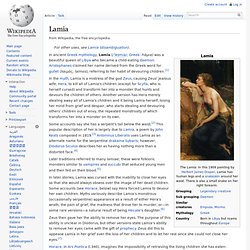
Another version has Hera merely stealing away all of Lamia's children and it being Lamia herself, losing her mind from grief and despair, who starts stealing and devouring others' children out of envy, the repeated monstrosity of which transforms her into a monster on its own. Later traditions referred to many lamiae; these were folkloric monsters similar to vampires and succubi that seduced young men and then fed on their blood.[5] In later stories, Lamia was cursed with the inability to close her eyes so that she would always obsess over the image of her dead children. Some accounts (see Horace, below) say Hera forced Lamia to devour her own children.
Zeus then gave her the ability to remove her eyes. Neu pranse Lamiae vivum puerum extrabat alvo. Mora (mythology) A mare or nightmare (Proto-Germanic: *marōn; Old English: mære; Old Norse: mara; German: Nachtmahr) is an evil spirit or goblin in Germanic folklore which rides on people's chests while they sleep, bringing on bad dreams (or "nightmares").[1] The word "mare" comes (through Middle English mare) from Old English mære, mare, or mere, all feminine nouns.
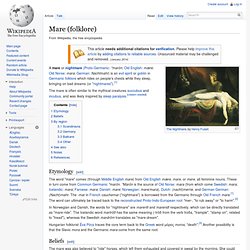
These in turn come from Common Germanic *marōn. *Marōn is the source of Old Norse: mara (from which come Swedish: mara; Icelandic: mara; Faroese: mara; Danish: mare; Norwegian: mare/mara), Dutch: (nacht)merrie, and German German: (Nacht)mahr. The -mar in French cauchemar ("nightmare") is borrowed from the Germanic through Old French mare.[1] The word can ultimately be traced back to the reconstructed Proto-Indo-European root *mer-, "to rub away" or "to harm".[2] In Norwegian and Danish, the words for "nightmare" are mareritt and mareridt respectively, which can be directly translated as "mare-ride".
In Romania they were known as Moroi. Mare (folklore) Death. Latvian mythology. The seasons, festivals and numerous deities of historic Latvian mythology reflected the essential agrarian nature of Latvian tribal life.

Much of its symbolism (an example is the pērkonkrusts or thunder cross) is ancient. These seasons and festivals are still celebrated today—for example, Jāņi is a national holiday.[1] History[edit] Territories of Baltic tribes at beginning of the 13th century. Early research sought to restore pagan religion practiced at the time. German mythology. Finnish mythology. Finnic mythologies. Finnic mythologies are the various mythologies of the Finnic peoples [nb 1], such as the Volga Finns, Baltic Finns, Permians, and Sami.[5] The mythologies of the Finno-Lappic speakers have some common aspects; the Sami people are deeply shamanistic, and these traits are present also in Finnish-Karelian mythology.
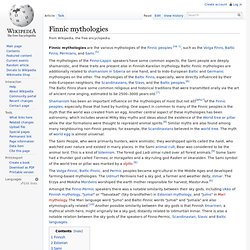
Baltic Finnic mythologies are additionally related to shamanism in Siberia on one hand, and to Indo-European Baltic and Germanic mythologies on the other. The mythologies of the Baltic Finns, especially, were directly influenced by their Indo-European neighbors, the Scandinavians, the Slavs, and the Baltic peoples.[6] The Baltic Finns share some common religious and historical traditions that were transmitted orally via the art of ancient rune singing, estimated to be 2500–3000 years old.[7] Shamanism has been an important influence on the mythologies of most (but not all)[who?]
Of the Finnic peoples, especially those that lived by hunting. Estonian mythology. Baltic mythology. Who are the Happy Gods? Who are the happy gods?
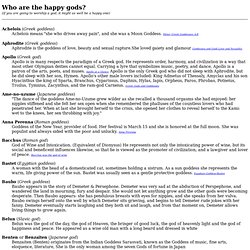
(if you are going to worship a god, it might as well be a happy one) Achelois (Greek goddess) Achelois means "she who drives away pain", and she was a Moon Goddess. Minor Greek Goddesses: A-E. Norse Mythology. Polish mythology. Polish mythology comprises beliefs and myths of ancient Poland, including witchcraft and elements of Paganism. The Polish pantheon[edit] Major gods[edit] Other gods[edit] Polish supernatural beings[edit] Prussian mythology. Historical background and sources[edit] The Teutonic Knights, a crusading military order, began the Prussian Crusade in the 1220s. Their goal was to conquer and convert pagan Prussians to Christianity.